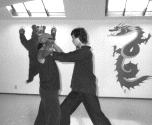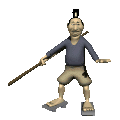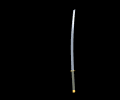
|
Once I had a dream.
In it, I had the good fortune to be living in
Monterey. I don’t know why Monterey, but I
recognized it, and it was bright and beautiful.
While there in the dream, I befriended an old Japanese
gentleman, for whom Monterey became home after leaving a
World War II internment camp. Within his
community, he was a revered master of weapons
arts. During our brief time together, he seemed
eager to pass some of his knowledge to me.
Pillar I: “Know” Your Weapon Sensei made it clear from the start. At the root of weapons study lies the special relationship that exists between man, and the world of objects. Studying a weapon rekindles this relationship. "Everything is a weapon. Wherever you are, whatever you have, know how to use it in every conceivable way." Understanding this, and making it your reality are not necessarily the same. "Understanding means talk, and has no substance!" he would say. “Take fire. There is a world of difference between understanding it on a philosophical basis, and knowing it on a practical basis. Anyone can "understand" fire by observing a burning match. But no amount of learning, study, or observation can give the practical understanding that holding your hand over a flame will. It is the same with the arts. People "understand" movement. With understanding, they execute perfect kicks, and dazzling combinations. Then, they master the "philosophy" of fighting. Thereafter, so long as they fight on a philosophical basis, they are successful. However, philosophy means nothing on the street. Beautiful sidekicks and dazzling combinations will not even slow an opponent who knows only self preservation." Pillar I is to know your weapon. Select a weapon. Then make it part of you. If you sense limitations to the weapon, look within yourself for the solution. There is nowhere else. Pillar II: In the End, Everything is a Weapon "Remember, everything is a weapon...," Master Archibeque spoke, eyes darting toward the handkerchief as he wiped sweat from his brow. On that sultry August afternoon, we had already finished an exhilarating warmup. Showing defenses, he ordered I attack with the mid-sized stick. As I did, he flared the handkerchief, parachuting it over my head. While I struggled to regain my bearings, he grabbed the corners of the handkerchief and launched a front choke, driving me to the ground. "My computer's working!" laughed Archie as I bounced in the dust. I attacked again, coming for the top of his head. He blocked upward, using the handkerchief as a snare against my stick. Suddenly, the snare snapped outward, launching my stick into space.
I attacked with a knife, and then a sword. He responded by snagging me, strangling me, smothering me, lifting me off the ground, and blinding me, always using the handkerchief. There seemed no end to the multitude of techniques he improvised on the spot. Sometimes, he did the likewise with other common objects. One autumn, we snacked on nuts while watching TV. He reached over, took an acorn, a pecan, a brazil nut, and a walnut. For over two hours, he showed how each could be employed in unique nerve attacks against incoming aggressors. Each held its secrets. What worked for the walnut did not necessarily work for the acorn. What one lacked in maneuverability, it gained in hardness. The brazil nut may have been awkward, but its shape allowed for nerve crushing attacks not available to the rounded shapes. They almost seemed to have been designed by a gifted craftsman, giving each its strengths, and each its limitations. Pillar III: Let the Weapon Teach You "The weapon is equal to any master in what it can show you, if you are receptive. Remember, it has a life of its own. You and the weapon move together. Take care of yourself, and the weapon will take care of itself." He stressed, "Weapons must be treated with the same respect you would reserve for an honored companion. I can think of countless instances where students failed because they did not show proper respect to their weapon. The weapon simply tolerated the abuse until the critical moment. When its powers were most needed, it responded with awkwardness." "Approach a weapon as you would a person. Empty your mind! Purge yourself of prejudice and bias! Let go of your conclusions! Let the weapon be itself, think for itself, move for itself. Don't do the thinking for it, and don't force it into a mold. Every weapon has a personality. Some are friendly, some playful, some impatient, some arrogant, and some viciously independent. Identify a weapon's traits before you form a partnership with it. If your personality and that of the weapon are not compatible, nothing can smooth the relationship. The outcome is a dead end. If you sense a troublesome relationship, terminate it at once. You may be avoiding serious injury." Pillar IV: The Bo Our Bo stood six feet tip-to-tip, its white oak sturdy enough to drop an opponent with one solid strike. "The Bo is a weapon favored by masters, if only because of its delightful personality. It is friendly, trustworthy, and patient. Moreover, it is omnipresent. Variations can be found in practically every environment."
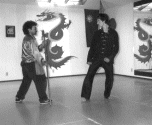 more can be expected from a weapon. If
the same were true for people, mankind would be content
and at peace." more can be expected from a weapon. If
the same were true for people, mankind would be content
and at peace."Though Sensei had great skill with the Bo, he seldom forced technique onto the aspiring practitioner. He took me aside, put a weapon into my hands, then demonstrated the first moves. Periodically, he checked progress to ensure I hadn't detoured. Occasionally, he added a move or disarm gained from his own experience with the Bo. What, with practice, it wasn't long before I surprised even him with new moves. Pillar V: The Middle Stick As the length of a Bo diminishes, it takes on new characteristics of movement. The shorter staff covers less area on defense, has less extension, a smaller amount of leverage, and less momentum on impact. Smaller and lighter, it gains in maneuverability and speed, opening a whole new universe of lightning attacks, disarms, and close-in counters. This is the domain of the middle stick. Ours averaged 28 inches in length. Like the Bo, the attitude of the middle stick is friendly. Its demeanor is fast and furious. Frequently, the exchanges run their course before the free roving eye registers what's transpired. Attacks are to the joints and critical body targets. Once the opponent is injured, he is immediately disabled and neutralized. Sensei referred to it as the mistress. Those of his students with an affinity for the middle stick, were always with it. When they jogged, a stick was in their hand; when they traveled, a stick was in the back seat of their car. After class, they could be seen standing for hours in front of the mirror, working concepts. Sensei joked he was teaching sticks, some of which had adopted humans as partners. Whether you specialized in the middle stick or not, you knew it was practical. It was always where you needed it, if you had the knowledge. Pillar VI: The Short Stick The short stick embodies "cobra." Usually constructed of exotic hardwood, and extending to twelve inches, it is preferred by the more experienced fighter. This is because it enhances the "inside" fight. Gone is the comfortable distance provided by the Bo, or the speed and ranginess of the middle stick. Like the cobra, the short stick holds its position patiently, then explodes, countering to a pressure point, joint, or vulnerable bodily organ. Of the three, the short stick is perhaps easiest to learn. Conversely, it is the most difficult to master. Because of its small size, the margin for blocking error is large. It is exclusively an insider's weapon, those who study the short stick become expert at inside fighting as an ancillary benefit.
This is the aristocrat of weapons. In line with its complex demeanor, the sword may be the most formidable of all 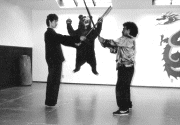 weapons to learn. One student
described, "Empty hand technique is like addition and
subtraction, working with the Bo, algebra. The sword goes
far beyond. There's no other weapon quite like it,
no other skill as exacting. It's almost as though
everything done before, is but preparation." weapons to learn. One student
described, "Empty hand technique is like addition and
subtraction, working with the Bo, algebra. The sword goes
far beyond. There's no other weapon quite like it,
no other skill as exacting. It's almost as though
everything done before, is but preparation."It demands perfection. Movements that were inconsequential with other weapons become important with the sword. Against a skilled attacker, even minor errors result in disfigurement or death. What may be a valid block with the empty hand, results in loss of limb against the sword. Recognizing the consequences of a touch, slash, or hit, the sword defender learns to close all openings to an opponent. 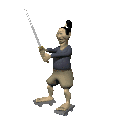 Repeated exposure develops a new array of
instincts, senses, and movements. If asked, "Why are
you holding the sword low? Why is your foot at a
right angle? Or, what is the next move you would
make from that position?" you will have definite
answers. With swords, everything has a purpose,
everything has a reason, everything leads to something
else. This is the principle of "Oneness." Repeated exposure develops a new array of
instincts, senses, and movements. If asked, "Why are
you holding the sword low? Why is your foot at a
right angle? Or, what is the next move you would
make from that position?" you will have definite
answers. With swords, everything has a purpose,
everything has a reason, everything leads to something
else. This is the principle of "Oneness."Sword concept is "one thought." In action, it is "one move." Defense and offense are "one." You learn to see attacks in your blocks, and blocks in your attacks, and to use them simultaneously and effectively in every situation. Having mastered the sword, you'll have new strength of limb and continuity of movement. Others will marvel that your moves seem to leap from the void. Your art will be characterized by spontaneity, explosiveness, and economy of technique. Facing others, you'll feel they are moving in still frame. While you are smooth, they are rough and riddled with stutters. As they search for openings, you have already penetrated. Pillar VIII: The Knife The knife is the "great equalizer." An opponent with a knife can defeat you, no matter what level your skill. This is the "knife wielder's advantage." Once a knife is present, anything can happen. In attitude, it is transparent. It reflects and magnifies the personality of the wielder, rather than changes it. It can be forceful in the hands of the thrust-and-kill attacker, or subtle and tentative in the hands of one who prefers to hit and run. There are some who are adept at throwing the knife. Others shudder to think that one would be thrown. My practice is to use a fighting knife for fighting, and a throwing knife for throwing. In essence, they are two different weapons. Regardless of what you're holding, throwing should be done only when the hit is certain. There are many theories on throwing the knife, and I have experienced two. The Western School recognizes a knife spins Hap Ki Do Master James Tille, an adept at knife throwing, graciously shared his training techniques, and the concepts he had studied in Korea. He brought samples of knives common to his school. Upon inspection, they appeared to be metal bars, weighing close to one-half pound apiece. Handles and razor sharp edges had been machined into each. When asked to demonstrate his throwing technique, he stepped off about twenty yards from the target. With what appeared to be complete disregard for distancing, he slowly raised his hand. Looking like he was doing Tai Chi, he released the knife toward the target. The grins on our faces wiped clean when, with a loud "thud," the knife planted firmly. He proceeded to a new location, and reproduced the outcome. We questioned him about rotations, and distance from the target, and why he set the knife on the flat of his palm. He replied that as far as he knew, this was how to throw a knife. He had never thought about the revolutions before, or about whether to hold the handle or the blade. To him, those issues didn't matter, and never presented a problem. We asked him to teach us the technique. By the end of the day, we were throwing his knives from all distances, and consistently sticking the target. Don't ask me to explain it. Just know that it happened! Pillar IX: The Handkerchief For Master Archibeque, this was "the first lady of weapons." Who would ever believe a defender could respond to an attack by snapping a handkerchief into the attacker's eyes, leaving him helpless and in pain? Putting a knife into your hand, he would invite your attack. "What shall I do, Sensei?" 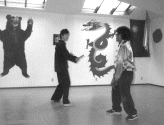 "Do anything you want...whatever comes to mind." You lunge forward. The handkerchief snakes around your wrist, pulls taut, and the knife is gone. Instantly the fabric coils around your neck, and you are falling to the ground. "The handkerchief has no substance, no strength, no force, and no form. Because no one believes you can do anything with it, it is perhaps the most deceptive of weapons. You can snap out at vulnerable targets, entangle your opponent, lift him off the ground, gag, smother, and blind him, all with a handkerchief." It was easy to see why it had become a preferred weapon for him. "Master the Handkerchief and you master the rope, the belt, the chain, the towel and other like weapons too numerous to list. Master the Handkerchief, and you will always have a weapon, even if it's the shirt off your back." The Final Destination As has already been mentioned, every weapon represents a family of concepts, and a constellation of physical motions. The Bo, the Sword, the Knife, the Middle and Short Sticks, and now the Handkerchief are all styles in their own right. The weapons described up to this point classify as traditional vehicles of instruction. You have reached the final destination when you can defend yourself using anything from your environment. On days when weather was too harsh for outdoor workouts, Master Archibeque invited us inside. Before long, his "computer" would start working and off he would dash, returning with some cryptic object. It might be a gum wrapper, a shoe, a comb, or even a plastic bag. If the group puzzled about the plastic bag, he would invite an attack. Instantly, the bag blocked the assailant's nose and mouth, leaving him gasping for air. On another occasion, a slice of bread was crumpled into the attacker's eyes. Afterwards, the student sat for minutes, eyes closed, shaking bread particles from the lids. As for the gum wrapper, Sensei walked up to the group, putting a piece of gum into his mouth. There was an attack, and instantly, the attacking student dropped to the floor in pain. No one saw what happened. That is, until Sensei revealed he had crumpled the wrapper, and used its stiff edges against the attacker's facial pressure points. Given to occasional levity, Sensei once ordered a student to attack with a knife. Complying, the attacker dropped suddenly to both knees. Looking for what bad caused the collapse, we found that Sensei had hurtled the shoe from his right foot, and struck the attacker's groin. Nothing more needed to be said. The more I saw, the more hopeless seemed the possibility of ever approaching Sensei's understanding of movement. However, as with all his teachings, he communicated to levels within us that our conscious minds could not distract. Over time, as I'd be eating breakfast, standing at a bus stop, or even, playing cards, I would be confident in what I could do should an attack come unexpectedly. Soon, I too was disarming, strangling, choking, gagging, and blinding with handkerchiefs, belts, socks, wallets, car keys, sheets of paper, newspapers, credit cards, pills, and candy wrappers...or anything else for that matter. Without knowing how, I had learned about myself, objects around me, and the shared relationship between the two. As Sensei often said, "They're all one in the end!" |
[Home] [About Us
] [Archie] [Concepts] [Contact Us]
[Gun
Fu Manual] [Kata]
[Philosophy] [Sticks] [Stories] [Web
Store] [Terms of Use]
[Video]
Copyright 2000-2025, Mc Cabe and Associates, Tacoma, WA. All rights reserved. No part of this site can be used, published, copied or sold for any purpose, except as per Terms of Use .
 This distinctive path presents a singular
contract to all students who tread it. Sensei
emphasized, "Whether you study Karate, Kung Fu, or some
other kindred pursuit, the arts are a partner with whom
you make a solemn compact. Performance returns
growth. Perform and you will be
rewarded. Fail to perform, and you'll get
nothing."
This distinctive path presents a singular
contract to all students who tread it. Sensei
emphasized, "Whether you study Karate, Kung Fu, or some
other kindred pursuit, the arts are a partner with whom
you make a solemn compact. Performance returns
growth. Perform and you will be
rewarded. Fail to perform, and you'll get
nothing."
